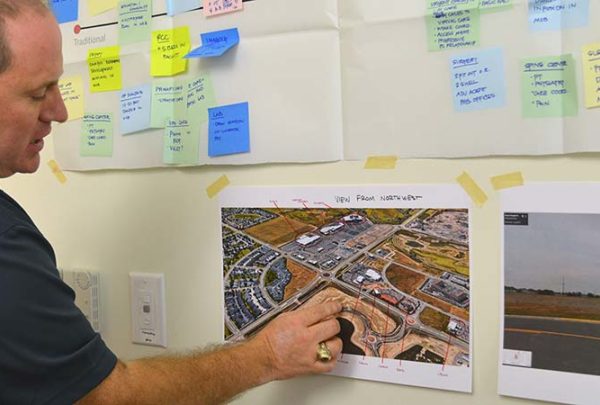So you think you have a big chaotic mess and don’t know where to start? The Emergency Department (ED) boards patients. Surgery and PACU backs up. Inpatient Average Length of Stay (ALOS) continues to increase, discharge times increase and patients wait for appointments. Patient satisfaction scores are not in the 90%+ category, or your facility’s market share is not at the level you would like.
While all these issues interconnect and likely stem from many factors, where do you start? What is the “force multiplier?” Could it be:
- Delayed lab or imaging results,
- Physician workflow doesn’t align with patient flow goals,
- Insufficient scheduling/capacity issues in the ORs,
- Inappropriate PAT processes,
- Slow intake process in the ED,
- Slow discharge process in the ED,
- Slow discharge process in the inpatient units or late inpatient discharge departures, or,
- Something more universal, like disenfranchised or tired staff.
Since 99% of all leadership occurs from the middle rather than the top, how do you guide your nursing leaders toward answers and strategies?
First, Look at Your Data – High Level but with Little Detail
Can you guess what the problem is? Good, you just revealed your bias!
Now throw that idea away for the moment and look with fresh eyes and an open mind! It’s easy to hold a bias for what we think is the problem, and until you look at the real data you are just guessing. Your patients and staff deserve better than a guess.
First review some data. It’s best to start by identifying trends in these metrics:
- How do patients enter your facility?
- Volume of ED, OR, Direct Admit by day. How many does each group admit? ALOS for each group?
- Patient satisfaction scores for each department/area,
- Staffing (including nurse leader) turnover and vacancy rate for each department/area,
- Patient and staff safety incident rates,
- Compare to Benchmark and best practice for each type,
- Compare to historic data.
Do you notice any trends? Which trend is the most strikingly negative? Which affects patient care and satisfaction the most? Can you determine its starting point?
You are looking for a root cause but at a high level. This exercise gives you the opportunity to cull out some of the noise and find the most prominent problem. Examples:
- ALOS in the ED is 40% higher than best practices,
- Door to Doc is 60% higher than best practice,
- Only 50% of surgeries start on time,
- Telemetry LOS is 35% higher, and so forth.
Departments trend data for many reasons, not the least of which is The Joint Commission and Medicare. This exercise gives you objective, supporting evidence of the problem(s) and an area of focus. Now, it’s time for a walk.
Next, Observe – Great Leaders Go to Their People
Armed with some hard numbers, go walk through the department of focus. Ask why? Round on staff, patients, physicians and reception/waiting areas. Especially, talk with staff. Why is the ED waiting room full at 9 am? Why is the ED boarding ten patients at 7 am? Why are five telemetry patients discharged but waiting for transportation (and holding a bed in the unit)? What is the barrier to moving the ICU patient to their assigned and ready bed on the Medical unit? Why is Surgery experiencing delays in start times? Are your surgeons and surgery department aligned?
The goal is to look at and understand process rather than just looking at results. Unless you have some kind of robust staff and patient tracking system your observations will be snapshots. But observations validate behaviors and it’s a great way to help figure out how people REALLY work.
Leadership rounding for purpose and outcomes requires intentional focus to not become distracted. Let “trends and root cause analysis” become a focused observation. These departments will often drive you crazy but they should be your best friends. As a CNO you do not want to get mired down in daily “stuff” and trending is the key to this and it is often readily available.
You can also engage others to find out what they observe, as sometimes it’s hard to see ourselves objectively. You can do this by asking different departments to observe each other. You can ask patients to observe staff. You can also survey or hold focus groups with patients, families, and ancillary staff. If you have Administrative Fellows, engage them in this work. Since people improve their performance when observed, you may not see the process at its worst. But you will still see some of the common roadblocks staff face every day.
Most of the time healthcare issues are complex and it’s difficult to find the root cause. Even asking why may only lead to other issues in other departments. So did you just make things more confusing? Not really, you know where the issue areas are, and you’ve seen the processes in action. If issues aren’t obvious quick fixes, then it’s time to drill down.
Drill Down to Find the “Root Cause”
There are a couple of methods to drilling down further. Based on what you found during your observation, you may want to review more detailed data. For example, if the ED waiting room is full during your observation time, is it always? Probably not, so look for long D2D times by day and hour. Are there arrival trends? Do those trends connect to inpatient, direct admit or OR volume surges? These connections allow you to create a macro view of the facility from a patient flow perspective. Track an ED or OR patient from point of entry to discharge home. Dig into how these flows affect and feed one another. The nursing unit backs up and immediately the ED follows suit
You now have a focus area and detailed data highlighting the current state. You also have benchmarks and best practices that help bookend the goals and a quantifiable problem to solve.
Delegate by Empowering Managers to Succeed
Once you have an idea of the issue you’d like to address first, empower managers to participate in developing the approach. Leaders in the middle are critical to the process of connecting the vision (“Let’s reduce ‘Tele Bed Assigned to Bed Occupied’ by 20 minutes”) and purpose (“Because we want to decrease ED boarding times.”) It’s important to confirm that middle-level leaders understand both the vision and purpose. And that they can communicate this to their team in a positive and influential way.
Don’t assume mid-level leaders can make a connection and lead their teams! Ask your leaders what they struggle with and where they need help. Ask what tools and support they need to coach, guide and engage their staff. Be sure that you’ve delegated to those with the right strengths to achieve the desired results. This may require reassigning some tasks to others if the leader has difficulty finding the time to make the issue at hand a priority. Or it may be as simple as redefining priorities together to empower the leader to focus on what’s most crucial first.
Enlist Department Staff
Take it to the staff. Give the staff the opportunity to contribute to the solution. It’s one way to engage staff in problem-solving. Staff need to understand the purpose, the why, of what you ask them to improve. Although a clear vision tells staff where they need to go, a purpose helps them grasp what you ask them to do and connects it to goals.
Need a Boost?
If speed, buy-in, and objectivity are important, then computer simulation modeling may warrant consideration. A simulation model shows the connections within and between departments without bias. It highlights problem areas no one may have considered. A model is excellent for determining root causes and testing divergent opinions on problems and solutions. In about eight weeks, a simulation exercise can generate a prioritized list of trouble spots and recommended improvements.
Ongoing Maintenance
Problems never completely disappear. Maintain your heightened awareness by initiating hospital-wide monthly check-ins or surveys or consider developing a dashboard that highlights accomplishments and root causes. These help identify what’s working and what isn’t. Gather stories of success and tell your stories often. Stories offer lessons, stimulate ideas, and motivate others to share their own success stories. Stories connect to purpose, worthwhile work with results, and making a difference. Know what defines success for the challenge, align your goals, coach and train for results, and track progress. And remember to celebrate and reward.







































































































